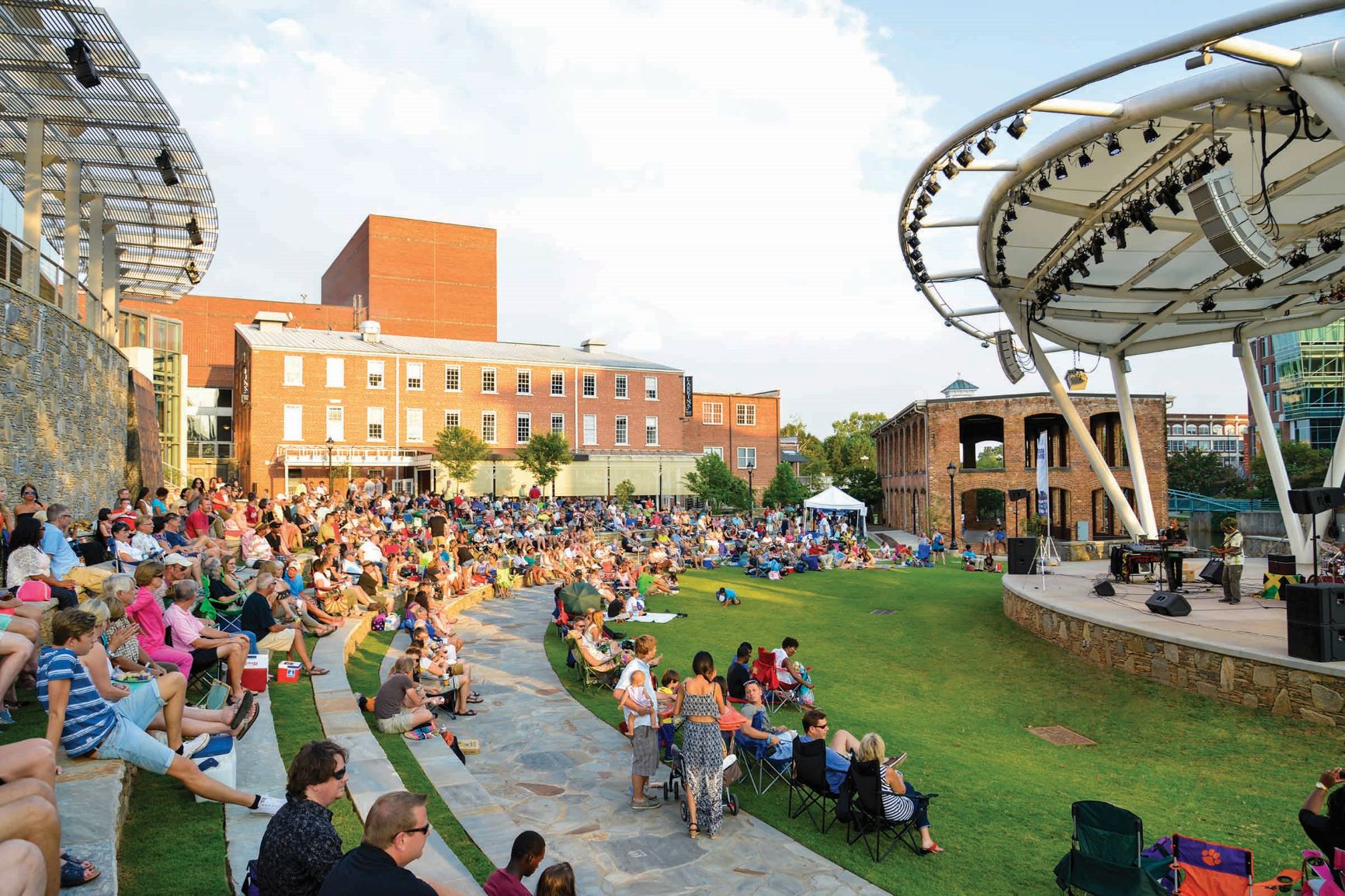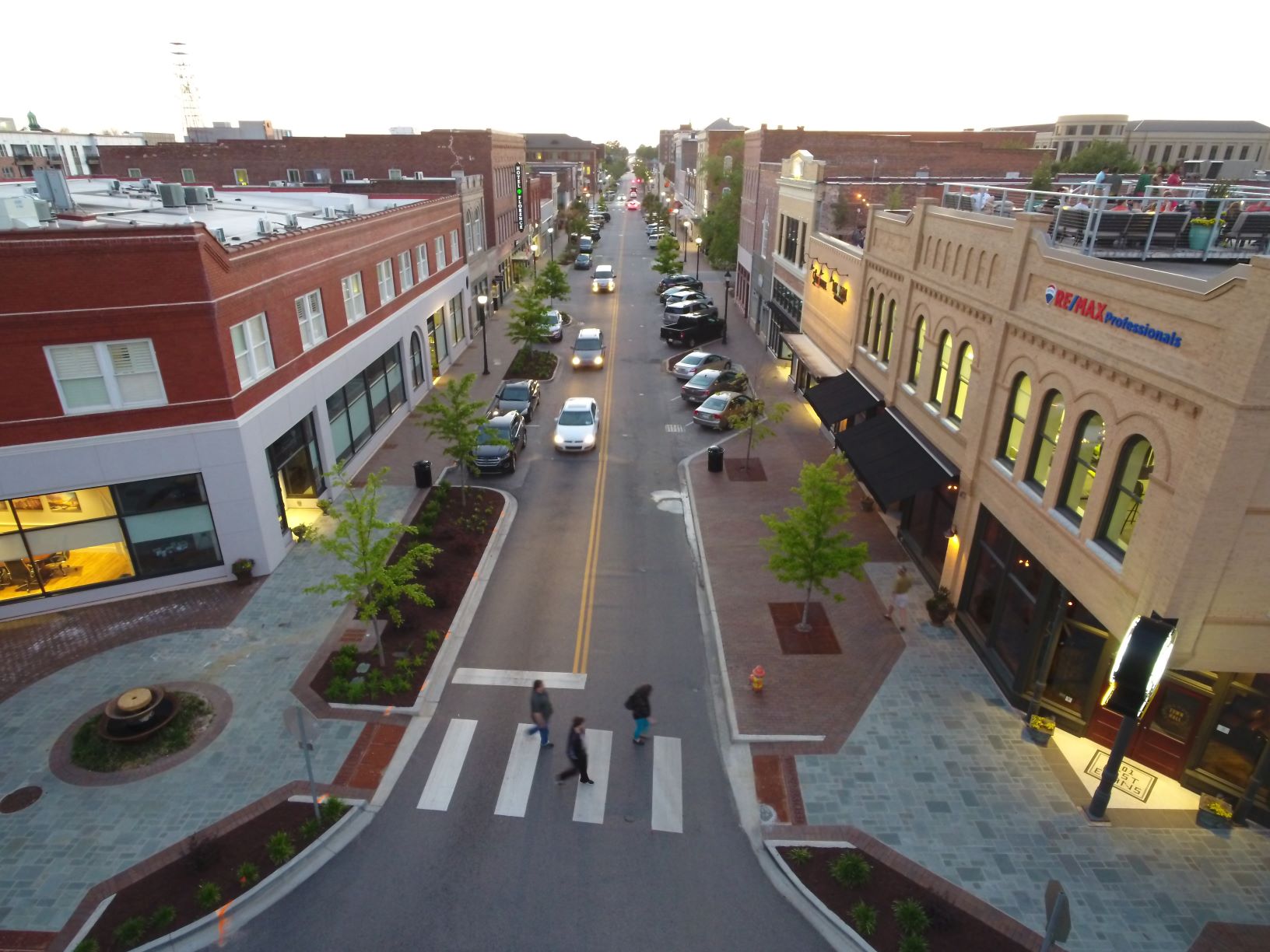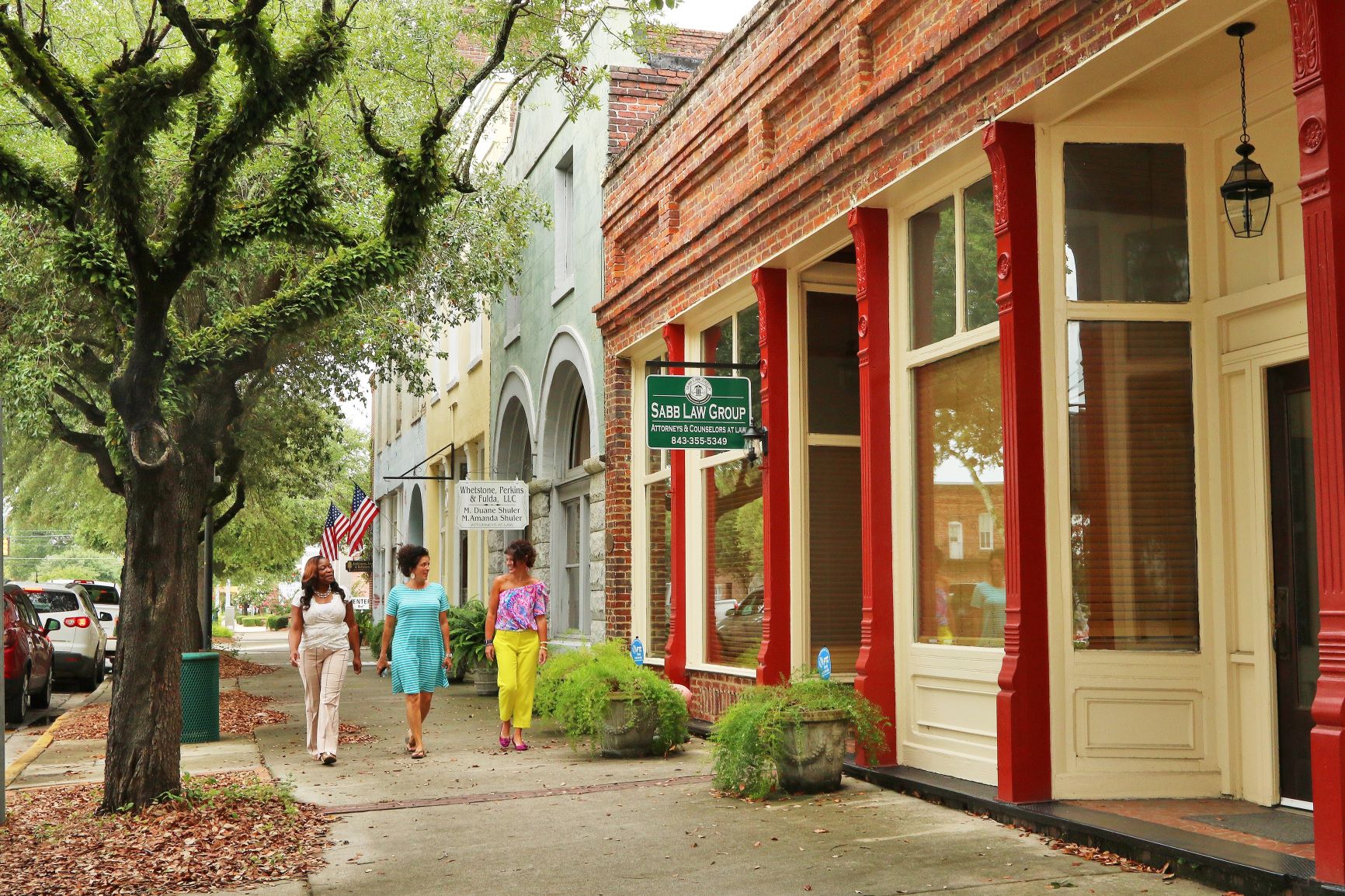In many ways, Kingstree, Florence and Greenville have little in common. Each municipality vary greatly in population, geography and history. Each city, however, has a vision for downtown, and a team that drives that vision. Leaders in these communities recognize that their downtown is the prism through which everyone sees how the city is prospering, and a strong downtown is a sign of a strong local economy.
Greenville
Build it, and they may come. Big fixes and eye-catching downtown projects do not always equate to immediate success. Steady, incremental triumphs can make all the difference, and the City of Greenville has proven it.

Families enjoy weekly concerts throughout the summer at the Peace Center
Amphitheatre in downtown Greenville. Photo: City of Greenville.
Compared to its status today, Greenville's 1970s-era business district would be unrecognizable — a place of empty streets and closed-up storefronts. Today, a shuttered storefront typically has a new occupant within weeks, given the district's reputation as an amenity-rich cultural, residential and commercial center.
The extraordinary story of Greenville's success began with Mayor Max Heller, whose Main Street projects laid the foundation for the new downtown. He left office in 1979, but his vision has continued with subsequent leaders including the current mayor, Knox White.
Mayor White took a calculated risk in focusing on Falls Park on the Reedy, known to many as the place where a waterfall flows through downtown, spanned by a pedestrian bridge. The major work on the park in the early 2000s created more recreational greenspace and arguably established a new identity for the city.
The next step was to focus on mixed-use development with a realistic evaluation of tenant composition. White noted that revitalization really took off when Greenville opened the door to residential development. Downtown now had life after hours and on weekends and a built-in customer base.
"Rather quickly, it began to feel different on the street. Building towards a critical mass gave life and vitality," White said.
Retail was the final piece, and the hardest. White stressed the importance of identifying small, sustainable business clusters. Downtown Greenville is a well-known restaurant hub, but it was the recruitment of Mast General Store that added practical and diverse shopping options. Once anchored, other complementary businesses organically blossomed along Main Street.
The impact of Greenville's emphasis on deliberate, strategic investment and constant care is easy to see. The city's success has become a playbook for others working to revive their downtowns.
White's fundamental recommendations for redevelopment: "Commit to planning; get good professional planning advice and more importantly, be intentional about implementing the plans. Focus like a laser on mixed use. Identify your unique local assets and create natural connections. Focus on safety, cleanliness. Redevelopment doesn't come naturally. Greenville leaders didn't just wish it to happen; they made it happen."
Florence
More than 180 miles from Greenville, the City of Florence took notice. As recently as a decade ago, the city was known to many as a quick refueling location on Interstate 95. By the 1980s or '90s, the city's once-thriving downtown stood vacant, neglected and decaying. In 2010, city leaders — facing much skepticism — took aim at a focused redevelopment of downtown's 70 square blocks.

West Evans Street in Florence has been the site of many building rehabilitations
and business openings in the past decade. Photo: City of Florence.
Recognizing the need for downtown leadership, Florence City Council took on lighting, policing, marketing and beautification projects. This public investment amplified community pride and spurred private investments. Today, downtown has new development successes including two hotels, a performing arts center, a museum and apartments. So far, the city counts $175 million in public investment and $80 million in private investment.
"The key to our success is that Florence was opportunist and proactive in creating public space, remedying parking issues and assembling property for future development," Mayor Stephen Wukela said. "This was a fundamental paradigm shift by local leadership. We recognized that the city needed to affirmatively mitigate risk, incentivize investments, spend money on infrastructure, and build coalitions of public and private entities to support downtown. The city acted as the catalyst with a focus on targeted opportunities."
Wukela noted that versatility and flexibility were also critical to success.
"All initial projects did not end the way they were initially proposed, but the results always ended up being better than originally considered," he said.
The city has been able to maintain the authenticity of its historic core while also meeting the needs of growth, Wukela said.
"Downtown," he said, "has become the place we gather."
City Manager Drew Griffin described Florence's approach to downtown projects as conceptual.
"We didn't allow a single detail to stop progress. In fact, a street was moved to ensure that a project was secured," he said. "We have been project-driven and pragmatic in all pursuits — we knew we had to succeed, and we use our comprehensive plan as our guide."
Downtown Development Manager Ray Reich said revitalization has to be an ongoing process.
"Just as the mall has staff that coordinate leasing, management and marketing, downtown commercial districts need ongoing attention, too. We must always make sure that what we create remains successful," he said.
Griffin's words of wisdom: "Build values, develop partnerships and take advantage of every source of funding. Create the vision, and stay on it."
Kingstree
Situated on the scenic Black River, the Town of Kingstree is known as a charming, family-friendly place. Even so, leaders recognized the need to establish the town as a destination for residents and visitors alike. Town officials visited other cities to learn about focused revitalization approaches and recently established Main Street Kingstree. That Main Street program is one of the newest partners of the Main Street South Carolina technical assistance program.

Kingstree is one of the newest participating communities in Main Street South Carolina.
Photo: Kingstree News.
Mayor Darren Tisdale noted that the Main Street approach, "while centered on downtown, reaches well beyond Main Street. Positive changes are felt across all of Kingstree."
"The Main Street program was just what was needed to help us take action," Town Manager Richard Treme said. "Through hard work and teamwork, we are developing a strong sense of place in our community."
The town is investing in itself with projects like a newly refurbished municipal parking lot. Kingstree is also becoming a hot spot for first-time business owners and family-operated enterprises — businesses like Monkey Bottom Boys, a catering company specializing in barbecue, Artsy Cakes and Bakery, and Bee Hive Gifts. The town encourages entrepreneurship through close support of existing businesses. Also, Main Street Kingstree Director William Freeman is working to find ways of connecting the river to downtown, as the town believes the Black River is an essential part of both its history and future.
Treme's words of encouragement for downtowns: "Success doesn't happen overnight. It requires constant commitment and dedication to the larger vision. Main Street is something you work on every day. You need to be progressing. Main Street gives us direction on where to focus and how to lead."
Mayor Tisdale noted the importance of unified leadership. "Mayor, council, staff, the entire community; we are all unified under one goal — to make Kingstree the place to be."
The formula for success
Jenny Boulware, manager of Main Street South Carolina, described creating or recreating downtown life as a process that needs community-driven economic development, but also placemaking efforts — specific projects that make the symbolic center of a community into a welcoming, desirable environment.
"Cities and towns hoping for a revitalized downtown, like the success stories we've already seen around South Carolina, can start small with actionable tasks," she said. "Everyone with a stake in the commercial district and its future should be involved. Encourage development agencies, city government, businesses and individuals to see traditional commercial buildings as community assets. Celebrate every success, from the planting of a tree to restored storefronts."
A strong historic core, she said, radiates economic benefits outward, and can in time benefit everyone in a community.
A preconference mobile workshop for the Municipal Association's Annual Meeting will tour downtown Greenville on July 18. Main Street South Carolina offers several membership levels ranging in cost and requirements for communities.
